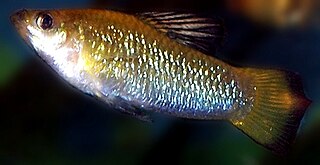
The black ruby barb or purplehead barb is a tropical cyprinid fish endemic to Sri Lanka where it occurs in forested streams from the Kelani basin to the Nilwala basin, they are found in streams on hills around 1000 ft in elevation. The brightly colored population introduced to Mahaweli at Ginigathena, Sri Lanka are said to have diminished in number due to the aquarium export trade.

Limia is a genus of livebearing fishes belonging to the Cyprinodontiform family Poeciliidae, which includes other livebearers such as platys, swordtails, guppies and mollies. They are found in fresh and brackish water. Of the 21 described Limia species, 17 are endemic to Hispaniola, one is found on both Hispaniola and Jamaica, and the Cayman Islands, Cuba, and Venezuela have an endemic species each. Limia are popular in aquaria among more advanced hobbyists.

The humpbacked limia or black-barred limia is a species of poeciliid endemic to Haiti. This species grows to a length of 5.2 centimetres (2.0 in) SL. It is also found in the aquarium trade.
Pydna is a genus of moths in the family Geometridae erected by Francis Walker in 1856.
The blackbanded darter is a small freshwater fish belonging to the genus Percina in the family Percidae. It is native to the river systems of the southeastern United States where it is found in the states of South Carolina, Tennessee, Georgia, Florida, Mississippi, Alabama, and Louisiana. It lives over sandy or gravelly bottoms in smaller rivers and streams and its color varies depending on the different habitats in which it lives. It feeds on small insect larvae and is itself preyed on by larger fish. It spawns between February and June depending on locality. It is a common fish throughout most of its range but is rare in the Altamaha River in Georgia.

The black-banded trevally is a species of carangid native to the Indian Ocean, the western Pacific Ocean, and the Atlantic coast of southeastern South Africa. This species inhabits reefs and rocky bottoms at depths from 20 to 150 m. This species grows to 70 cm (28 in) in total length, and the maximum recorded weight reached is 5.2 kg (11 lb). It is of minor importance to local commercial fisheries, but is popular as a gamefish. This species is the only known member of its genus.

Sybra is a genus of beetles in the family Cerambycidae, containing the following species:

Sybra umbratica is a species of beetle in the family Cerambycidae. It was described by Pascoe in 1865.
Sybra bioculata is a species of beetle in the family Cerambycidae. It was described by Pic in 1925. It contains four subspecies: Sybra bioculata bioculata, Sybra bioculata quadrinotata, Sybra bioculata sikkimana, and Sybra bioculata tigrina.

Sybra ordinata is a species of beetle in the family Cerambycidae. It was described by Bates in 1873.
Sybra pascoei is a species of beetle in the family Cerambycidae. It was described by Lameere in 1893.
Astathes nigrofasciata is a species of beetle in the family Cerambycidae. It was described by Breuning in 1956. It is known from Thailand.
Lasiocercis nigrofasciata is a species of beetle in the family Cerambycidae. It was described by Stephan von Breuning in 1964.
The blackstripe herring is a fish that can be found in the Pacific Ocean around Sonora, Mexico. Its diet consists of pelagic crustaceans, zooplankton, pelagic fish larvae, and pelagic fish eggs. It prefers a depth of about 10 m max. It poses no threat to humans, and is of least concern on the IUCN Red List status.
Cacia nigrofasciata is a species of beetle in the family Cerambycidae. It was described by Gressitt in 1940. It is known from China.
Pterolophia nigrofasciata is a species of beetle in the family Cerambycidae. It was described by Stephan von Breuning in 1938.
Leuconitocris nigrofasciata is a species of beetle in the family Cerambycidae. It was described by Per Olof Christopher Aurivillius in 1925.
Serixia nigrofasciata is a species of beetle in the family Cerambycidae. It was described by Maurice Pic in 1926.
Trigonoptera nigrofasciata is a species of beetle in the family Cerambycidae. It was described by Judson Linsley Gressitt in 1984.
Copella nigrofasciata is a species of fish in the splashing tetra family found in the upper Amazon basin, ranging from Manaus into the Ucayli River. They grow no more than a few centimeters.








